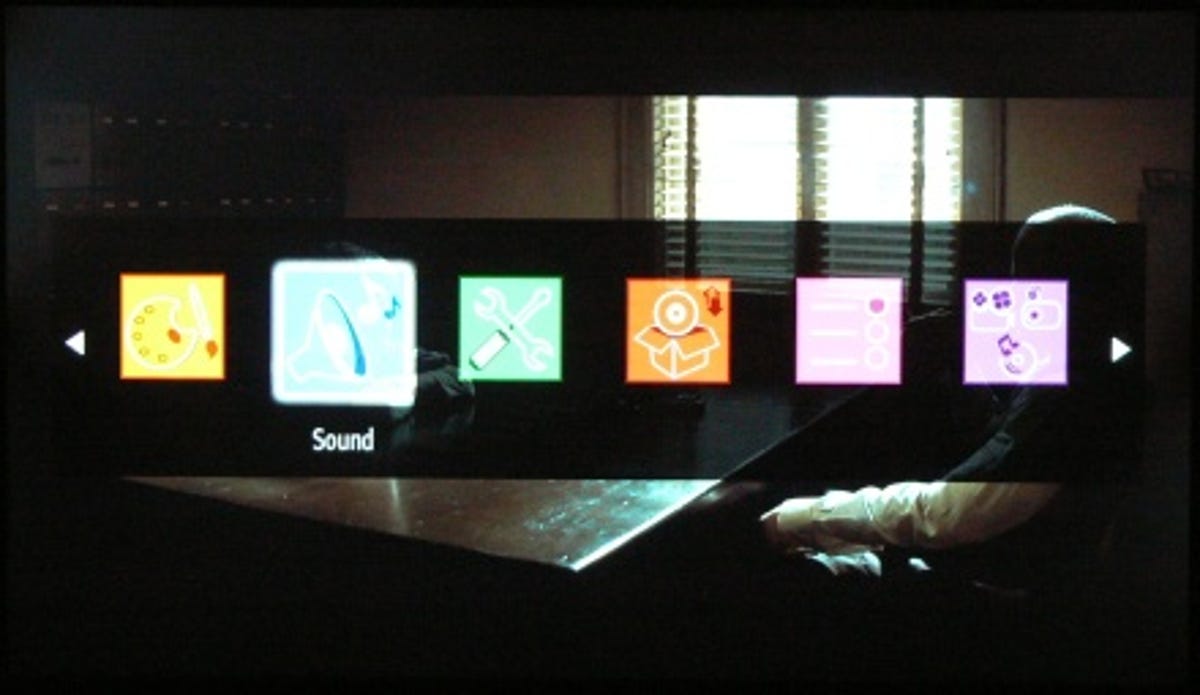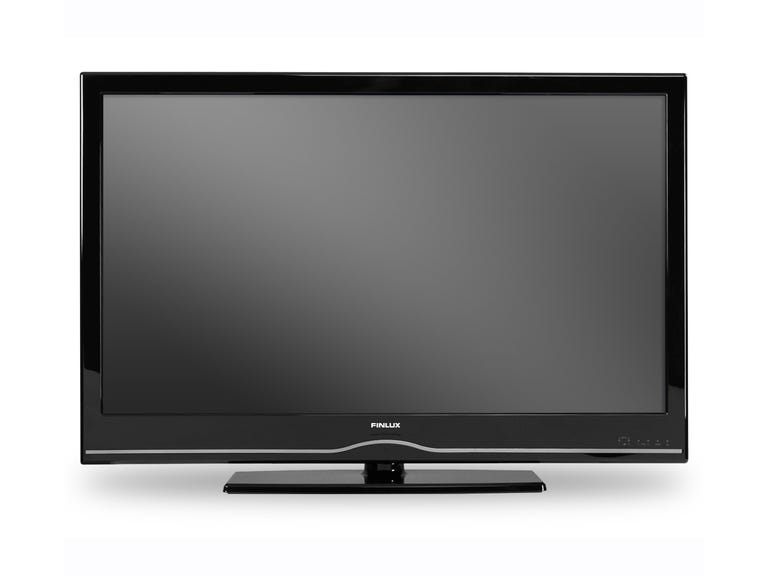 Why You Can Trust CNET
Why You Can Trust CNET Finlux 32F703 review: Finlux 32F703
The 32-inch Finlux 32F703 offers real value for money, and aside from a few niggles, it's a good performer with both 2D and 3D content.
The Finlux 32F703 is only available to buy from the Finluxdirect.com website, but to tempt you out of your comfort zone, the Finnish company is dangling a 32-inch screen with video recording features and passive 3D technology -- all for a mere £300.
The Good
The Bad
The Bottom Line
On paper it looks like a total bargain, but how good does it perform in the flesh?
User interface and EPG
Finlux was once owned by Nokia, but is now part of Vestel, a company that makes many of the own-brand TVs you see down your local supermarket. Typical of a budget model, you can forget about the flash graphics that you now find on mid-range TV interfaces from Samsung or LG.
The menu system is flat and a little dull. Call up the main menu and you're greeted by a banner of icons running across the middle of the screen for stuff like Picture, Sound, Settings, Tuning and the Channel List. At least when you enter the menus, the various options are neatly listed inside a transparent grey box.

The range of picture tweaking functions is simple but quite effective. Along with the usual contrast, brightness, sharpness and colour controls, you can adjust the colour temperature, as well as the balance between Red and Green using the colour-shift slider.
The sound menu provides good levels of control over the set's audio output. There's a 5-band graphic equaliser, so you can fine-tune the low, mid and high frequencies to your own preference. Finlux also provides a Dynamic Bass boost setting but the TV does lack any pseudo-surround sound modes. That's perhaps no bad thing on a budget set, as these modes are often unusably bad on cheap TVs.
If the menu system is a muted success, the electronic programme guide (EPG) is less impressive. When you hit the EPG button on the remote, you're only shown what's currently on and what's up next. It doesn't list all the programmes coming up over an evening. If you want to that, you have to press the yellow button on the remote while you're in the EPG. This then shifts to a standard bricks-in-the-wall style layout with channels listed down the left-hand side of the screen and upcoming programmes shown on a timeline to the right.
Why Finlux couldn't have made this the default mode, I just can't understand. It really is a pain having to go through two button pushes to access it, especially as the EPG button is at the bottom of the remote and the yellow button at the top.
There's also a third EPG mode called List Schedule that shows one channel's worth of data at a time. This tends to only show limited chunks in one go, so you have to continually press the green button on the remote to see the next slice of EPG data.
Also, when you call up the Now and Next banner via the Info button while watching a show, there's no way to view more details about the programmes you're tuned to. On most TVs, hitting the info button a second time displays this information, but that's not supported here.
Digital media and Internet features
Given this TV's low price, I wasn't expecting it to have any smart features -- so it's no surprise that it doesn't. What it does have is a USB port that can be used both for playing back digital media from memory keys and hard drives and for recording shows to disc.
The media player can be accessed from the main menu. Alternatively, you can call it up quickly by pressing the media player button at the bottom of the remote. The interface is rudimentary -- you simply select the type of media you want to play (videos, photos or music), and you're dumped into a file browser.
In the manual for the TV it says the player supports MPEG 1, 2 and Xvid files, but I couldn't get any of my Xvid files to play, so format support seems to be more limited than Finlux makes out. Nevertheless, I had no problems using the set to view JPEG photos or listen to MP3 files.
When you attach a USB drive or key to the TV, you can also start to take advantage of its personal video recorder (PVR) features. Recordings can be scheduled via the EPG. Alternatively, just start recording the channel you're watching by hitting the record button on the remote. The set supports chase play too, so you can watch the start of a program while the end is still recording. There's also a timeshift function that lets you pause live TV, say to answer the phone, and then resume where you left off.
Once your recordings have been made, you can access them by pressing the Display button on the remote. Recordings are tagged with the name of the show, unlike some sets that add obscure file names to recordings. So it's easy to find what you want to play. Overall, the PVR functionality is nicely implemented for such a budget set.
Design and connections
This is not the TV to buy if you're looking to impress your mates with sexy tech. This model uses older CCFL backlighting rather than the LED variant found on most of today's sets, so it's a lot thicker than many on the market at the moment. In fact, it's fairly thick even by CCFL standards, measuring 95mm deep.
The bezel around the screen is wide too, especially at the bottom, where it extends down for 80mm. Still, the polished black finish on the front does at least mean it's likely to blend in quite well with other bits of AV kit that you own.
There isn't an abundance of connection options around the back. Finlux has only added two HDMI ports, so it's going to be inconvenient if you've got more than two HD devices. The rear is home to a full-sized Scart socket, as well as a coax digital output, so you can feed the sound from the onboard tuner to an external amp.
Unfortunately, the tuner is Freeview only, so you can't use it to pick up HD channels. That probably won't be a problem if you've got a third-party TV service, such as Sky or Virgin Media, but it's a downer if you still get your channels through an aerial. The right-hand side of the TV houses the composite input port as well as the sole USB slot. That's your lot as far as connections go. As I've said, the options are a tad limited.
Audio quality
This TV has two 6W speakers built into the chassis. That might not sound like much on paper, but they actually do a pretty good job of delivering punchy audio. Good mid-range presence means dialogue comes across as fairly crisp and clear and the set is capable of delivering decent bass levels too, especially if you tweak the 5-band graphic equaliser in the Sound menu. High-frequency elements of the audio lacked energy, but overall, this is not a bad sounding TV.
2D picture quality
The backlighting may come courtesy of older CCFL technology, but the panel still has Full HD resolution. And anyway, using CCFL on budget TVs is not always a bad thing, as Sony's KDL-32CX523 proved last year. In fact, it seems to be a clever move on the part of Finlux as colour and black level performance actually belie its bargain basement price.
The picture presets aren't actually too bad, especially the Natural and Cinema modes. But by tweaking them slightly -- it's best to lower the backlight setting to medium and turn the brightness down to around the 38 mark -- you can improve the TV's performance quite a lot. Once it's been properly set up, pictures are surprisingly good. It delivers quite realistic skin tones, avoiding the palsticky look that afflicts many budget TVs.
Colours on the whole are nicely rendered and never descend into the unruliness that affects lesser TVs. Once you've adjusted the backlight and brightness settings, black levels are reasonably deep without losing lots of shadow detail.
Naturally, things aren't perfect in the picture department. There was noticeable backlight bleed on the right-hand edge of the review unit, which was a tad annoying, especially watching darker scenes. There's also some judder on slower camera pans in movies, especially when you're watching films in HD, and motion blur raises its head now and again.
3D picture quality
The fact that this set includes 3D support at all at this price is a minor miracle. It's built around an LG panel, so it uses passive rather than active 3D technology. However, passive has a number of advantages, not least of which is the cheap glasses, of which Finlux includes four pairs in the box. The glasses are light and comfortable to wear. As they're passive, they don't cause you to see flickering where there's lots of ambient light in your room, as active glasses generally do.
One drawback with passive 3D technology is you don't get Full HD images delivered to each eye, as you do on active sets. Instead, the passive filter in front of the screen splits the panel's resolution so every second line of the display gets fed to a different eye. This sometimes means you can actually make out the missing lines on larger sets, especially if you sit close to the screen. But this model's 32-inch screen means it isn't a problem.
In fact, 3D images actually look quite sharp and crisp. If you sit at a normal viewing angle, there's almost no crosstalk -- or image ghosting -- visible either. You do have to be careful how you position the TV though. If you've got it sitting too low from your seating position, the 3D images will break up and you'll see double ghosting of the image. That's only likely to be a problem if you've got the TV perched on top of a very low-profile cabinet.
The lack of crosstalk helps to suck you into the 3D experience and makes the impressive depth all the more believable. My only real complaint on the 3D front is that the 32-inch size is perhaps not large enough to allow you to fully enjoy the 3D thrills on offer.
Conclusion
Manufacturers find it difficult to strike a balance when it comes to budget sets. They want to get the price as low as possible but compromise on picture quality too much to achieve it. Finlux has largely avoided this pitfall on the 32F703. It's cheap as chips, yet manages to offer pretty good picture quality for the money and decent 3D performance to boot. On that basis, I think it offers very good value for money.


